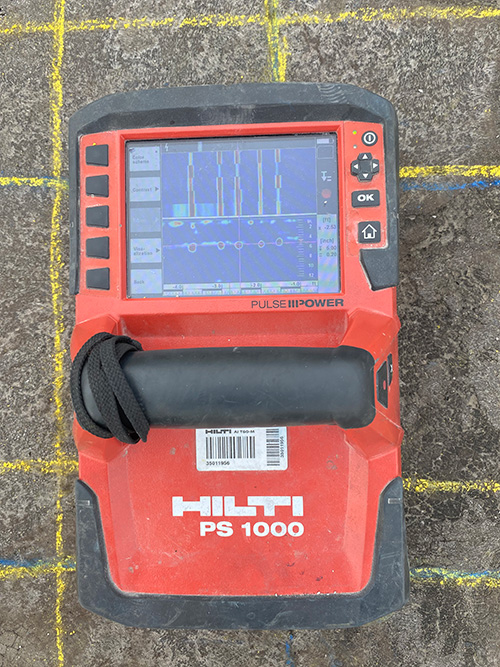Reveal the Transformative Power of Concrete Scanning in Maximizing Performance and Safety
Concrete scanning has arised as a vital tool in the building sector, using exceptional advantages in enhancing job efficiency and making sure safety criteria. By using advanced innovation, concrete scanning enables experts to see beyond the surface area, uncovering covert complexities that could influence the structural stability of a structure. The transformative power of concrete scanning hinges on its capability to offer real-time data and detailed insights, reinventing how projects are prepared and performed. As we look into the ins and outs of this innovative method, a globe of possibilities opens, showcasing a brand-new era of construction techniques that prioritize accuracy and protection.
Importance of Concrete Scanning
Guaranteeing the structural stability and safety of building jobs starts with the vital action of performing comprehensive concrete scanning. Concrete scanning is a non-destructive method used to spot and map subsurface elements within concrete structures. This process is essential in recognizing prospective dangers, such as rebar, post-tension cords, and channels, that might be hidden within the concrete. By utilizing advanced innovations like ground-penetrating radar (GPR) and electro-magnetic induction, building teams can precisely find these aspects without causing any type of damages to the framework.
Furthermore, concrete scanning aids in maximizing job timelines and budget plan by preventing unforeseen prices and delays that might emerge due to unexpected blockages within the concrete. Eventually, spending in thorough concrete scanning is a positive strategy that enhances both performance and security in construction tasks.
How Concrete Scanning Works
Concrete scanning operates as an important device in building and construction tasks by utilizing innovative technologies to detect and map subsurface aspects without causing structural damages. Ground Passing Through Radar (GPR) and Electromagnetic Induction (EMI) are two key methods utilized in concrete scanning. GPR works by discharging high-frequency radar pulses into the surface area, which get better when they experience subsurface items or gaps. The moment taken for the signal to return shows the deepness and place of the things. EMI, on the various other hand, utilizes magnetic fields to identify variances in material compositions, such as identifying rebar or avenues within concrete structures.
During the scanning process, the data accumulated is evaluated in real-time, permitting instant identification of possible risks or barriers below the surface area. By employing these advanced technologies, concrete scanning dramatically reduces the risk of expensive damages and injuries on building and construction sites.
Advantages of Concrete Scanning
Utilizing sophisticated scanning innovations in building and construction jobs offers a multitude of benefits, enhancing both effectiveness and safety and security on-site. One of the primary advantages of concrete scanning is the ability to discover and locate ingrained items such as rebar, post-tension cable televisions, and channels accurately. By identifying these components prior to drilling or cutting right into concrete frameworks, the threat of accidental strikes is considerably decreased, avoiding possible injuries to workers and damages to the framework itself. Concrete scanning assists in preparation and creating extra efficiently, as it supplies exact info about the place and depth of architectural components.

Study: Concrete Scanning Success

In another case, a building and construction company made use of 3D concrete scanning to evaluate the home condition old concrete structures in a historic building. The detailed scans supplied valuable understandings right into the extent of deterioration and assisted focus on maintenance initiatives effectively. By proactively addressing areas of concern determined through scanning, the business had the ability to extend the lifespan of the structure and ensure resident security.
These study underscore the transformative power of concrete scanning in boosting effectiveness, precision, and safety in construction tasks.
Executing Concrete Scanning in Projects
Carrying out innovative scanning technologies throughout construction jobs has actually ended up being progressively necessary for boosting accuracy and safety and security. By integrating concrete scanning right into project preparation and execution, building and construction teams can identify prospective risks, such as rebar or post-tension wires, hidden within concrete structures. This positive method minimizes the danger of crashes, delays, and expensive rework, eventually leading to a lot more reliable job timelines and spending plans.
To implement concrete scanning effectively, project supervisors must collaborate carefully with knowledgeable scanning specialists to determine the most suitable scanning techniques for the certain project demands. Engaging scanning specialists from the beginning of a project allows the team to produce extensive scanning plans that attend to key locations of concern and make sure detailed data collection.
Additionally, integrating concrete scanning right into routine job process can enhance decision-making procedures, as real-time check information provides immediate insights right into the condition of concrete structures - Concrete Scanning. This data-driven technique helps with educated analytical and allows groups to make adjustments quickly, cultivating a culture of efficiency and security throughout the project lifecycle

Conclusion
To conclude, concrete scanning plays a vital duty in improving effectiveness and security in building jobs. By utilizing advanced technology to map and spot out underlying frameworks within concrete, this procedure helps to stop expensive errors, make sure structural stability, and reduce risks on site. With the capability to discover covert components and offer exact information, concrete scanning verifies to be an important device for maximizing job end results and maximizing general success.
Concrete scanning is a non-destructive technique utilized to discover and map subsurface components within concrete structures. Furthermore, concrete scanning check that helps in optimizing job timelines and spending plan by preventing unanticipated costs and delays that might occur due to unpredicted blockages within the concrete. One remarkable case study includes a large remodelling job where concrete scanning played an important function in ensuring task success.In an additional situation, a building and construction company utilized 3D concrete scanning to assess the condition of maturing concrete frameworks in a historic structure. By incorporating concrete scanning into project Click Here preparation and implementation, building and construction groups can determine prospective hazards, such as rebar or post-tension cables, concealed within concrete structures.
Comments on “Choosing the Right Concrete Scanning Tools”